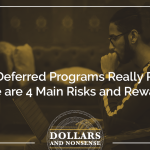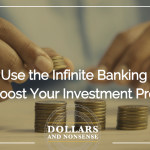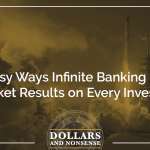In this episode, we discuss how focusing on the rate of return can be very misleading. We’ll also share how using the infinite banking process can help you make more money on every investment opportunity that comes your way.
One of the most challenging concepts for people new to the Infinite Banking Concept is that it is a banking system and not an investment. In other words, it is the system you need to be able to do investments. But we have to start with the system first and then look at the rate of return for what you’re looking at investing in. Today, we deep dive and explain why this is true.
Topics Discussed:
- What rate of return is often abused by people offering investments
- How rate of return can be helpful and sometimes deceptive
- Games played with the average rate of return that can trick you
- Factoring risk into the equation
- How IBC is a banking strategy and why it is not an investment
- Understanding the real goal of the infinite banking concept
- The ways IBC differs from investment opportunities
- How infinite banking can enhance rate of return
Episode Resources:
- Gain access to our Secret Banking Masterclass now FREE to listeners of the podcast here now
- Why Dave Ramsey is wrong
- What is Infinite Banking
- Who was Nelson Nash?
- CREDIT: Episode art background photo by Lili Popper
Podcast transcript for episode 134: Investment Rate of Return Bias
Nate: In this episode, we discuss how focusing on the rate of return of investments can be very misleading and how using the infinite banking process can help you make more money on every investment opportunity that comes your way. She’s Holly. And she helps people find financial freedom.
Holly: He’s Nate, he makes sense out of money. This is Dollars and Nonsense. If you follow the herd, you will be slaughtered.
Nate: All right, well, welcome back everyone to the show. We’re excited to bring another episode on, this is a top big that comes up in conversation quite often, just in life about how investments are doing, what rate of returns we’re seeking. It’s such a big part of people’s financial decision making process. And of course, Holly and I hear about it all the time, whether it’s what investments out there paying high rates of return or whether it has something to do with the infinite banking policies and what their rate of returns are and trying to compare things. So we thought we’d just essentially, Holly, just dive in today with a discussion on the idea of rate of return. What place does it have whenever you’re trying to decide between different financial strategies, how it can be misleading a lot of the time, how it can be abused by the people offering investments, as well as how infinite banking can actually help improve rates of return of investments and so forth. So I thought we just dive into a few of these topics that I feel are pertinent to people trying to find their way financially.
Holly: Well and I think, Nate, the key here too is a lot of individuals will say, I can a higher rate of return if I invest in this, and they really view the life insurance policy and the infinite banking system as an investment, and yet really what our goal is in this is trying to help you guys understand this is the system you use in order to make decisions and making those investments and how it makes that investment better. But you really can’t take a life insurance policy and compare it to an investment opportunity and say, well, one has a better rate of return, because you’re really talking about two different things.
Nate: Exactly. Right. I think we maybe dive into that here in a moment, as far as the details go of what make infinite banking’s all about and why rate of return doesn’t really come into the discussion in the same way that rate of return may come into the discussion when you’re trying to compare investment opportunities. Always keep this at the forefront of your mind when you’re pursuing the infinite banking concept, you’re not pursuing a new investment opportunity, you’re pursuing a new banking strategy. So at the end of the day, whenever we’re trying to compare investment opportunity to investment opportunity, that comparison’s a little different than when we’re trying to compare banking strategy to banking strategy. Two different modes there, and I think sometimes we get our wires crossed when we’re trying to compare a banking strategy to an investment opportunity. Things get weird really quickly.
So I think we’ll dive into that too. Holly, I thought maybe we could kind of jump into how people can abuse rate of return, how people can mislead people, the mutual fund industry, or-
Holly: Yes.
Nate: I got an investment opportunity for you. It’s averaged 12% rate of return over the last five years or something like that.
Holly: Yeah.
Nate: And how people can talk about these averages, but yet they can be extremely misleading, and just to kind of show this all, just before the podcast, I went out and I looked at what was the average stock market return from 1990 to 2010. So if you just look at like the S&P500 index, and you were putting, let’s say $10 a year, $100 a year, you’re paying some sort of annual contribution of any amount towards the S&P500, what would’ve been your rate of return on average, over that 20 year period?
The average rate of return is like 8% from 1990 to 2010. So if I was to contribute, so that’s a 20 year period, and so if we’re trying to look back and we can assume, okay, well, if I had contributed a thousand dollars a month over those 20 years, at 8%, I would end up with a certain [inaudible 00:04:20] dollar figure . The problem was the actual rate of return is different than the average rate of return. The actual rate of return was like 4.7%. So what the heck is the difference? What is the difference between you look at the stock market performance on average, and it says, well, it averaged an 8% rate of return, but then whenever you actually try to figure out how much money would you have made in the actual rate of return experience by a real investor is different.
How’s that possible? Well, it actually solely has to do with the sequence of returns actually matter more than the average return. So to compute in average, Holly, what you’ll do is you’ll just add up all the gains and all the losses over 20 years, and then divide it by 20. So you have a 10% year, a 5% year, a negative 5%, a 20%, a negative 30%. And you just add up all of these gains and all these losses, and then you divide by 20, and that’s how you would compute an average rate return. That’s the average return over 20 years is you just take all of them, add it together and equal 20. The problem with that though, is that money doesn’t work this way.
Let’s use an exaggerated example, and then I’ll get off this, this mode of focus, but how it can be deceptive, because let’s just say I had an investment and I put $100,000 into an investment, and it earns a hundred percent rate of return in one year. So essentially I doubled my money in one year, I earned a hundred percent rate of return. So now my $100,000 is turned into $200,000. And the next year I lose 50% rate of return. I lose 50%. So now my, my $200,000 is cut in half. And I’m actually just right back to what I was the day before. I’m back at $100,000. I had an increase of a hundred percent and then I had a decrease of 50%, my actual return is 0%. Can we all agree with that?
Holly: Yep.
Nate: I’m back where I was. My actual rate of return, I started out with $100,000, I’m back at $100,000, my actual return is zero, but my average rate of return, remember to compute average, all you do is add the two returns together and then divide by two. So in a two year period, I take my a hundred percent one year and add it to negative 50 the next year. So a hundred percent plus negative 50 is 50%. And then I divide by two. I have an average rate of return of 25% in my investment portfolio, and yet I made no money.
This is why this rate of return concept, it is very valuable, but it actually is very deceptive, because anytime you lose money, the averages just go out the window. They don’t even compute anymore. So the real key is the actual rate of return that people will experience, and as I said, from over 20 years, the mutual fund could say, Hey, we did 8% over the last 20 years on average.
Holly: Yeah.
Nate: But yet you actually experience, because of all the up and downs, you actually only experience 4.7%. That’s a huge, huge difference. But yet people who are focused on average rate return and all these, they can swindle people into thinking their investments are really good because these average rate of return numbers can get all wonky and they can kind of manipulate them to show what they want to show.
Holly: Well, and Nate, we talk about the fact that what they do is they tickle your ears, you hear this number and you think that’s so awesome. That’s amazing. And even today I was talking to in an individual, same thing, ears tickled, right? And oh, I put this much money into my mutual funds five years ago, right? And they haven’t even, what they’ve actually earned is not much. In fact, they’re like, why is this happening? And I’m like, because you were told an average versus your actual numbers and oh, okay, well, can I put that in a policy now? But what they heard was this is the average, this is what this product’s been doing literally for the last 10 years, so it’s a good investment for you. People hear actual and average, and they think it’s the same thing when it’s not. The average is what is promoted to appear as if it’s a really great investment, and it’s a great opportunity, and you don’t actually realize that those actual numbers are different. When you hear people throwing out 8% average or even-
Nate: Or Dave Ramsey’s 12% mutual funds.
Holly: 12% average. Yeah.
Nate: How many people are actually experiencing a real 12% net to them year on year for 40 years?
Holly: Yeah.
Nate: But yet, that’s what they base the numbers on, it’s just not happening to the average individual. And I see this happening big time in like a commercial real estate syndication deals. So in other words, a group is going to go buy an apartment complex and then refinish it, refurbish it, increase the rent, increase the value, spit money back to you and so forth, and we have a lot of clients doing those and it can work out really well. The problem is though, is that they’ll tout all these returns that they’ve made in the past for these different deals, but that actually it just has no bearing on whether the commercial real estate property that you dive into through the syndicate is actually going to perform for you.
So a lot of times we look at rates of return as our decision maker. It is an important piece of an investment opportunity, it really is, but you can’t just look all only at past performance and you can’t just look at whatever the guy on the other side of the phone tells you that this is what we’ve been experiencing. Being in the industry myself, we hear the horror stories of our clients trusting somebody, worked with them, and then it goes bankrupt and they end up losing money and it happens more often than we want to give a credit for. So rate of return while it’s important, it is not the end all be all of your investment opportunity. It can also depend on your goals. I say this all the time, too, Holly, that there’s different kinds of rate of return. There are some things that are called appreciation rate of return.
Holly: Yeah.
Nate: That would be more like the stock market, is more of like it’s not actually built to necessarily draw income from it. It’s based on just appreciation and market value of assets. That’s one type of rate of return that would fit somebody’s objectives differently than someone who’s looking to have steady, solid income. That’s a completely different style of return, like buying a rental property and receiving a rent check every month. They’re two different types, so you can’t just look at the average rate of return or the numbers and say, that’s what I want, whatever’s going to produce the highest number to me, that’s what I want, because the investment needs to help you achieve the objective you’re trying to achieve. Not every objective’s the same. And so different assets produce return in different ways. And the rates can kind of be manipulated to where one’s better than the other under certain circumstances and not under others.
Announcer: Are you still stuck in insecurity and uncertainty? Do you want to feel like a financial genius and confident about your future? Holly and Nate have prepared something exclusively for Dollars and Nonsense listeners, it’s called the Secret Banking Master Class. You can gain free access to this course by visiting livingwealth.com/secretbanking. That secret banking, all one word. The course will share with you how the conventional system stacks the deck against you, and exactly how to break free from their system. We believe in challenging the status quo. We believe in defying conventional wealth tools while maintaining traditional values. After all, most of those conventional tools only ever seem to make someone else on the inner circle rich. Visit livingwealth.com/secretbanking. That’s secret banking, all one word. Ease your worry and start your journey towards security today. Visit livingwealth.com/secretbanking. Now back to the great episode with Nate and Holly.
Nate: So it’s a landmine, that’s for sure, when we dive into rate of return discussion and what play or what place should the rate of return have in decision making? It’s got to be there, but it cannot be the end, all be all of your financial decisions.
Holly: I think you also have to understand that there’s risk involved with rate of turn. And if you’re seeking this golden goose, the, oh, this is just the best investment ever, right? And you’re going to get this amazing rate of return. That’s when you should be more cautious or realize when you’re willing to try and get a higher rate of return, you’re also sacrificing or taking more risk with your actual money.
Nate: Absolutely. That’s a good point. Anytime you hear somebody say we’ve been experiencing these great rates of return and they never bring up what the possible risk is to you, you got to run for the hills, because there’s no such thing as a free lunch. In other words, we’ll hear this said all the time, the more risk you take, the higher rate of return. That’s not true. The more risk you take, by definition, you have to, if you’re taking a lot of risk to achieve something by design you have to be, no one would take a lot of risk for a low rate of return. The highest risk and the highest return is the lottery you could put in a tiny amount, you could buy one ticket and win a hundred million dollars. It’s not the greater the risk, the rate of return, it’s just simply by the greater the risk, no one would take a great risk without the possibility for a great return.
So the problem with risk is that risk means the likelihood of loss, the probability of loss. So essentially what you’re saying is the higher the probability that I will lose money will indicate that I could also receive a higher rate of return. Yeah, that’s true. But you can’t just say the more risk, the more reward. That doesn’t exactly make sense in general, because once again, just because something has a potential high rate of return probably means that there’s some risk that you at least should identify and define before you jump in with whatever that investment opportunity is. Define the risk, understand it and accept it. But don’t just dive in because someone said, earn a whole bunch of money, earn 12% with whatever this investment opportunity is, and that’s what my buddies are doing right now, whatever it is like that. That’s just dangerous. It’s very dangerous to not know what the risks are.
Holly: Well, and I think Nate too, that it’s not just knowing the risk, but when people want me to invest or they come to me, you also I think, should also ask, well, how much are you putting in? Because if this is an investment that somebody wants you to participate in, are they willing to put their own money in into it?
Nate: That’s exactly right. I’ve been pitched some opportunities by other people who haven’t put money and I’m like, no, like who do you think I am? No way. If it’s not good enough for you, it is not good enough for me. You definitely want people to have some skin in the game. And back to that risk style discussion, at the end of the day, you have to define the risk. So if we compare that to like just investing in the stock market, doing the 401k, IRA style situation, what is the risk there? The risk is the fact that it’s all of your investments in a mutual fund and a stock market based investment are based on market value at the time. There’s market consideration. There’s no real value to it. It’s a piece of paper that people buy and sell and trade, and there’s no necessarily real value to it, other than whatever someone else will give you for it.
So we all know there can be huge swings in that type of environment. We’ve seen many of them, but I’m saying that the real risk is when you get in and when you get out. The real risk to stock market investments is you don’t what the value of your mutual fund portfolio or your stock portfolio, you don’t know what the value’s going to be when you actually need the money. That’s the real risk. I think we can all look at past history and realize that yes, stocks do over a long period of time, they tend to go up obviously. And so we’re not saying, systemically, yeah, it likely will go up over time.
The problem is you don’t know what the performance is going to be at the time you need it. So that is the big risk you’re you’re taking whenever you decide to build your financial life around the conventional American way, which is stuffing money into the stock market through your retirement program. The problem is you just don’t know what the valuations are going to be when you actually want the money, whether that’s sooner, or whether that’s later on down the road, when you’re in older age and looking to retire or whatever it is, we just don’t know what the value’s going to be. And it can be anything. We just don’t know. So every investment opportunity has some sort of risk and some element of risk. You have to define what that is and either accept it or don’t and go find something else if that’s the case.
But Holly, as we’re kind of butting up for time you year, I thought we could kind of move the discussion to one of our pet topics, obviously infinite banking.
Holly: Yeah.
Nate: And really just a lot of people when they go down the path of learning about infinite banking, trying to figure out if it’s something they want to do, common questions are rate of return questions.
Holly: Sure. Yeah.
Nate: And as I said at the very beginning, I feel like rate of return is a very important piece of the puzzle when you’re looking for investment opportunities, but since our goal is not actually to invest money in life insurance, we have a different goal. I feel that the rate of return comparison to investments needs to go by the wayside, and there’s a few reason for that, I’m sure we can dive in, but answering the question of like why in the infinite banking community do we not spend a ton of time talking about the rate of return of a policy? What about this system makes it so where we’re not treating it as an investment opportunity, we’re treating it as something else?
Holly: Well, I think if you think of it as an infinite bank, as a bank, it’s your own privatized banking system that you’re depositing money in and then using that money, whether it be for an investment or to purchase something, but I mean, this is the way I’ve kind of been telling clients recently, Nate, is when you go to your bank, do you ask them what the rate of return is when you’re making a deposit?
Nate: I don’t.
Holly: You don’t. You’d be like, no. Well, it’s an infinite banking system. This is your own privatized bank. So why are we getting stuck on what’s the rate of return for the insurance policy? It’s not an investment and it’s not considered an investment. It is literally a place for you to actually make premium deposits and then be able to access and borrow and use that money as a shareholder with a mutual fund receiving dividend. So it’s a different concept. It’s not an investment. It’s literally a system you’re putting in place to be able to put your money in able to access and use it again, get paid interest on that and use that money versus a bank where you’re just depositing it and they’re loaning it out and using it and making all the money for themselves.
Nate: Yeah, exactly right. It’s essentially, as I said, we ought be comparing this to other ways that you can finance and practice banking. That’s really what we’re after. And the missing piece that answers the question for most people is simply the fact that with an investment opportunity, the reason rate of return is important is because you’re always comparing to what else you could have done. So in other words, if I’m going to buy into some sort of, whether it’s a mutual fund or whether it’s a piece of property or real estate, or whether it’s land or whatever it is, I’m going to buy that and plan on leaving money there for a period and the whole point of leaving the money there is to have it grow, and then I sell it later at a profit.
And so I’m looking for investment opportunities, rate of return is a huge piece of it. In fact, it’s one of the main pieces.
Holly: Yes.
Nate: But inside the life insurance policy, inside the infinite banking world, the goal is not to buy a life insurance policy and let it sit for a long time. That’s actually not the goal, just like you don’t really want to put money into a checking account and let it sit there for a long period of time. You’d rather have money be working for you and keeping it in motion. So the reason why we don’t typically compare the infinite banking process and these policies that we have to other investment opportunities is because we’re not against you investing money. We would just show you how to fund the investments through a different banking format. That’s really what we’re trying to do.
So instead of building up money in a bank account, and then using that to make a down payment on a rental property, we would show you how to build up the same money into a policy, and then use the policy to make the down payment on a rental property. And of course, by doing so you can actually make profit in two places at the same time. Inside the policy, the money’s going to continue to compound and earn dividends even while we’ve borrowed it out to use inside the rental property. And then hopefully the rental property is profitable, and so it’s making you money, so we can make money as a banker and as an investor, whereas most people, banking is a zero sum game. We don’t make anything. We only make money as an investor. We don’t actually have any idea how to make money as a banker.
So this is the reason why we don’t focus on the rate return for life insurance policy as a reason to do infinite banking, because in and of itself, it is not an investment to us. It is the banking tool that we use to fund everything in life, which includes investments and how it can make us additional profit by being the owner. The rate return is important very often, but it has to be when you’re deciding between investment opportunities, but the banking strategy has to be compared to how else we could finance the things of life. What else could we do to fund our investments and buy cars and go on vacation and send our kids to school and do charitable giving pay taxes. All these things that we’re trying to do anyway, the question is how much money are you able to make financing all of those things in your current situation, and then what would happen if we were to do the infinite banking solution to those same situations, and you’ll notice you just make a lot more money. That’s because the banking system is not built for you in the conventional way, but infinite banking only profits you. So let’s dive in.Holly: Absolutely. I couldn’t have said it better, Nate. That really it’s the system you need to be able to do investments, to be able to make your money do more than one thing for you, but you have to start with the system first and then look at the rate of return for what you’re looking at investing in.
Nate: So yeah, one of the main reasons, and it’s not like we’re shying away. I actually do believe that policies grow very well and it’s guaranteed to grow at no risk to us, and there’s no taxation on it and it’s very consistent and you can’t just lose money because the market has a bad year or something like that. It’s always increasing. There’s a lot of value to the asset of a policy, but why we don’t, I’m not here to tell you that a policy is a better investment than X or Y or Z, and drew all these comparisons is because we are not buying it as bad. You have your wires crossed. You’re putting the infinite banking concept and comparing it to investment opportunity when it was never meant to be that in and of itself.
You can use it as that. In other words, it will grow. You will earn a profit. You will earn a rate of return inside of the policy, but at the end of the day, what we’re after is the process of banking and how we can manipulate that to produce us profit as compared to the other ways we can do it and how we can make every investment opportunity that comes our way, earn us even more money by making money as a banker and as an investor at the same time. That’s really what it’s all about. Any other points here, Holly, before we close it down?
Holly: No, that was excellent.
Nate: All right. Very good. Well guys, thanks for joining us. This has been Dollars and Nonsense, if you follow the herd, you will get slaughtered.
Holly: For free transcripts and resources, please visit livingwealth.com/e134.
Announcer: Dollars and Nonsense podcast listeners, one more thing before you go. Ease your worry and start your journey towards security today. Visit livingwealth.com/secretbanking. You’ll gain instant free access to the special one hour course Holly and Nate made for you. Again, that’s livingwealth.com/secretbanking.













